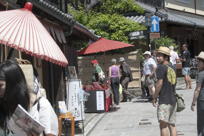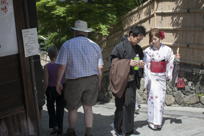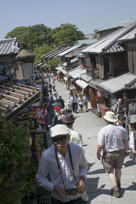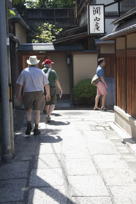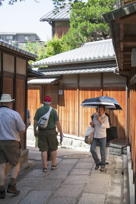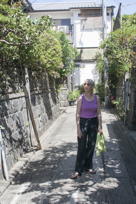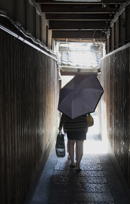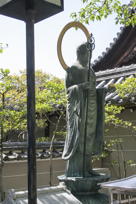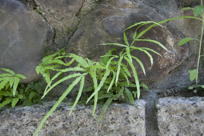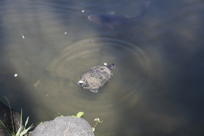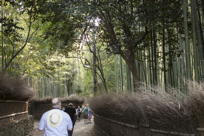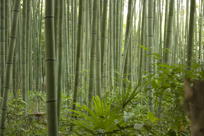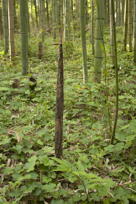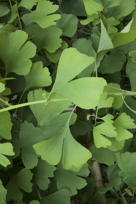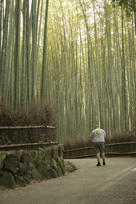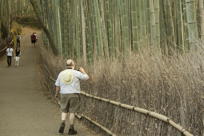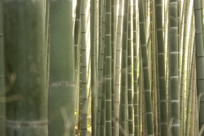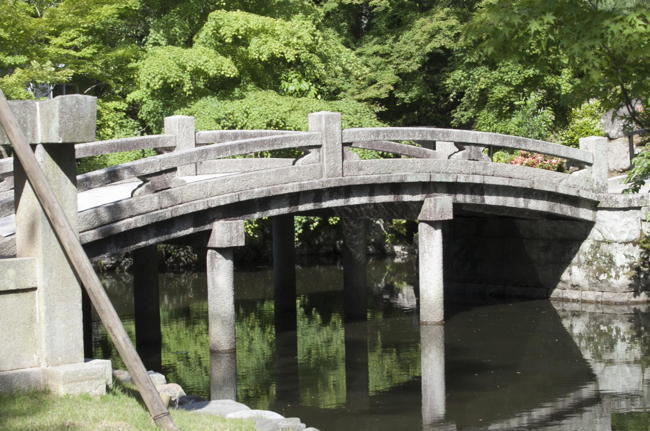
|
| Bridge over calm waters in the gardens of the Kōdai-ji temple (bigger image). |
Wednesday, 28 May: our
second day in
Kyōto ( part II )
We left that shrine, and found ourselves on a shopping street, where some of us investigated one shop or another. Top left over there to the left, there they are shopping; top right, I wanted to show the couple both in kimono.
In the lower row, the left picture seems to show us walking down a sloped shopping street. I don’t recall anything special about this; the next two, though, are of us walking in what was billed as the Most Beautiful Street in Japan (or maybe in Kyōto). We liked it fine, but we weren’t as overwhelmed with the beauty as that billing would have suggested.
Down below, I just liked the picture of Cindy in an unspecified alley. And in the pedestrian tunnel, I tried my best to get the warm backlit purple of the umbrella, but of course you never succeed fully.
Below them, two nature pictures; a fern on the left, and as I’ve said before, I find ferns very interesting, so am always on the lookout to photograph unusual ones. And on the right, that is clearly a red-eared slider from the Southeastern United States, one of the 100 most invasive species worldwide. They’re big in the pet trade, and they get released frequently. Above that in the picture, you can see a koi, seemingly swimming with equanimity near the invader.
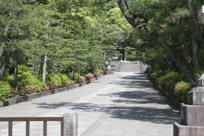
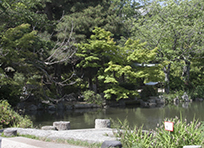
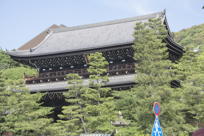
The next main stop after the most
beautiful street was the
Kōdai-ji
Temple, and in fact some of the pictures above were taken
in the gardens attached to the Temple, namely the Buddha, the
fern, and the slider. Over to the right, the entrance to the
temple grounds, the same pond where we saw the turtle, and a
distance view of the temple itself.
My journal is completely silent about this temple, but according to Mark’s account, the two of us sat outside, while the others went to see the sights inside. Maybe we were just eager with anticipation for the next big thing of the day.
And the next big thing was the district of Arashiyama, and its Sagano Bamboo Forest. We took a couple of trains from the neighborhood of the Temple, and it was a little walk through town streets before we got to the Forest, but it was really quite unusual.
There were other trees growing in it, but the overwhelming majority of them were bamboos. A most unusual sight, for us. In the second row, to the left, the left snap shows a sprouting shaft of bamboo. If you’ve ever had to contend with bamboo in your garden, as we did when we were living in Pasadena, you know that seedlings are unknown: propagation is vegetative, by ropy horizontal roots below or on the surface that sprout distressingly vigorous shafts like the one in the shot, though in our garden they weren’t as thick.
In the middle of that row, Ginkgo leaves, from a small specimen, as I recall. The tree is native to a relatively small area in China, but was imported into Japan very long ago.
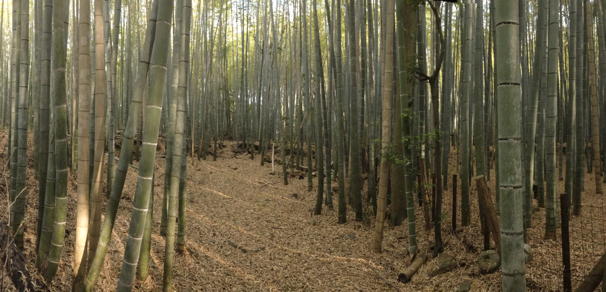
|
| One more view of the Bamboo Forest (with a much bigger version). |
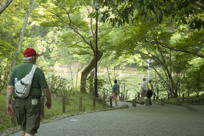
Walking to the Ōi
(big image,
small).
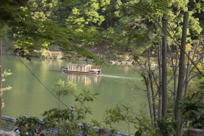
Looks like a tourist boat
(big
image, small).
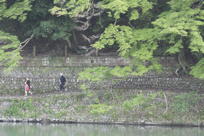
The feeling one got in the bamboo forest was entirely different from how you feel in a broad-leaf or conifer wood. It was rather eerie. We walked through to a path that led to the left and downward, and got to the river, which seems to be the Ōi.
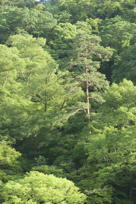
It’s not that there was all that much to see on the river. A strange boat passed by going downstream, I would have said that it was an overgrown sampan, till I looked up what a real one is. It seemed to have seats in the roofed-over part, so I figured it might be something for tourists to take a ride up and down the river in. But there were no people visible in it. Walkers and runners along a path on the other side, and an occasional bird, which I was pretty much unsuccessful at capturing in a snapshot. The forest on the other side seemed to be mixed hardwood, but I noticed a lonely pine among the broadleaf trees, pictured over to the left.
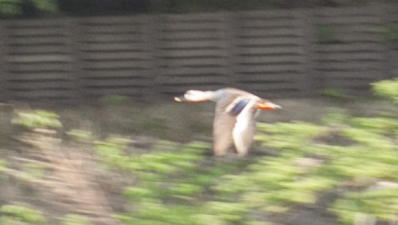
|
| The best picture I could get of a bird. Duck? |
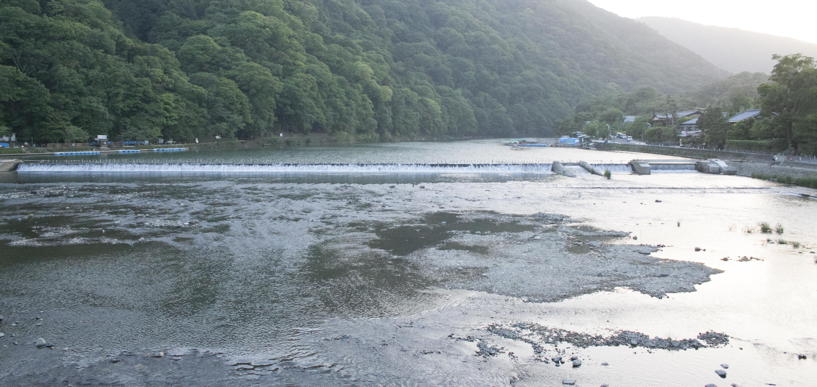
Looking upstream to the dam and beyond. Our stopping place would have
been |
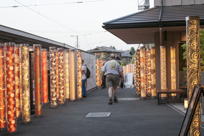
Mark enters the show (big image, small).
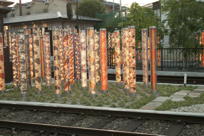
Kimono between the tracks (big image, small).
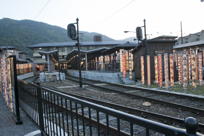
The scenery was not the best part of our visit to the river’s edge. The best was just great relaxation. My journal says, «…down to the river, where we found a little snack-joint and got five welcome Sapporos. The owner was kind enough to supply us with wet-napkins and a small bowl of edamame as well. We sat and enjoyed ourselves; nearby was an English-speaking Gaijin with two young Japanese people. As we were getting ready to go, he engaged us in conversation. It turned out that he was from Montréal, explaining his slight accent in English, and had been in Japan for 35 years. Recommended Okinawa highly, as long as you got out of the main town. Like Hawaii but with fewer people on the beaches.»
We left this congenial resting place where we had spent so much time, and walked downstream past a low dam, to a bridge that we crossed, but where we stopped to stand and look back upstream. My journal continues:
«Then walk back to the JR train station, past another station with a “Kimono forest”, and our local train took us quickly to Kyōto, where we went to a particular restaurant that Mike wanted to get to. We had to sit at the counter, but it was very pleasant. I ordered grilled mushrooms, and when the dish finally came, it wasn’t what I had expected at all. All on a hot cast-iron shovel, clearly cooked right on that, and it was three little portions of omelette and two other indesribables, one of which had mushrooms in it. This was entirely different from any other meal I’ve had in Japan, but completely satisfying and filling.
«From there to the Ryokan and to bed.»
